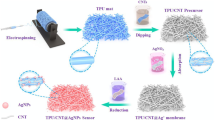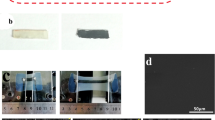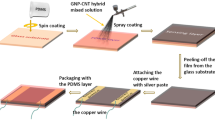Abstract
Electronic textiles present an enticing prospect for personal health assessment and physical monitoring, owing to their strong stretchability, high flexibility, mechanical robustness and high capacity in sensing small deformations in human motions. Herein, a multifunctional robust flexible knitting-shaped strain sensor based on the functional heterostructure composed of the conductive MXene (Ti3C2Tx) nanosheet and the antimicrobial Cu2O nanoparticles is prepared via a solution-processable dip-dry coating approach. The textile-based strain sensor exhibits a highly stable and immediate response over a wide range, which shows great advantages in detecting and monitoring human activities, such as smiling, swallowing, and wrist/finger/joint bending. Significantly, these prepared strain sensors present a promising application in smart wear, which was typically employed as the smart sensing gloves in barrier-free communication for hearing-impaired people. Interestingly, the different resistance evolutions of the knitted sensor under both low and high strain were carried out to study the sensing mechanism for the first time. Notably, the strain sensor displays a reliable antibacterial efficiency of ∼99.1% for Escherichia coli and outstanding breathability as high as 190 mm/s. This developed MXene/Cu2O hybrid materials supplies a new insight for the rational design and synthesis of multifunctional nanomaterials, as well as the achievement of the flexible wearable sensor with high performance.
Graphical abstract






Similar content being viewed by others
Availability of data and materials
Not applicable.
References
Azimi H et al (2014) Effective ligand passivation of Cu2O nanoparticles through solid-state treatment with mercaptopropionic acid. J Am Chem Soc 136:7233–7236. https://doi.org/10.1021/ja502221r
Cao YM et al (2021) Smart textiles based on MoS2 hollow nanospheres for personal thermal management. ACS Appl Mater Interfaces 13:48988–48996. https://doi.org/10.1021/acsami.1c13269
Chen C, Boota M, Urbankowski P, Anasori B, Miao L, Jiang J, Gogotsi Y (2018) Effect of glycine functionalization of 2D titanium carbide (MXene) on charge storage. J Mater Chem A 6:4617–4622. https://doi.org/10.1039/c7ta11347a
Cheng S, Han S, Cao Z, Xu C, Fang X, Wang X (2020) Wearable and ultrasensitive strain sensor based on high-quality GaN pn junction microwire arrays. Small 16:1907461. https://doi.org/10.1002/smll.201907461
Deng S et al (2012) Reduced graphene oxide conjugated Cu2O nanowire mesocrystals for high-performance NO2 gas sensor. J Am Chem Soc 134:4905–4917. https://doi.org/10.1021/ja211683m
Dong K et al (2020) Shape adaptable and highly resilient 3D braided triboelectric nanogenerators as e-textiles for power and sensing. Nat Commun 11:2868. https://doi.org/10.1038/s41467-020-16642-6
Gao J, Jiang B, Ni C, Qi Y, Bi X (2020a) Enhanced reduction of nitrate by noble metal-free electrocatalysis on P doped three-dimensional Co3O4 cathode: mechanism exploration from both experimental and DFT studies. Chem Eng J. https://doi.org/10.1016/j.cej.2019.123034
Gao Y et al (2020b) Winding-locked carbon nanotubes/polymer nanofibers helical yarn for ultrastretchable conductor and strain sensor. ACS Nano 14:3442–3450. https://doi.org/10.1021/acsnano.9b09533
Ghidiu M, Lukatskaya MR, Zhao MQ, Gogotsi Y, Barsoum MW (2014) Conductive two-dimensional titanium carbide “clay” with high volumetric capacitance. Nature 516:78–81. https://doi.org/10.1038/nature13970
He Y, Gui Q, Wang Y, Wang Z, Liao S, Wang Y (2018) A polypyrrole elastomer based on confined polymerization in a host polymer network for highly stretchable temperature and strain sensors. Small 14:1800394. https://doi.org/10.1002/smll.201800394
He F et al (2020) Stretchable, Biocompatible, and multifunctional silk fibroin-based hydrogels toward wearable strain/pressure sensors and triboelectric nanogenerators. ACS Appl Mater Interfaces 12:6442–6450. https://doi.org/10.1021/acsami.9b19721
Huang J et al (2019) Highly sensitive and stretchable CNT-bridged AgNP strain sensor based on TPU electrospun membrane for human motion detection. Adv Electron Mater 5:1900241. https://doi.org/10.1002/aelm.201900241
Jang H, Park YJ, Chen X, Das T, Kim MS, Ahn JH (2016) Graphene-based flexible and stretchable electronics. Adv Mater 28:4184–4202. https://doi.org/10.1002/adma.201504245
Li Q et al (2016) Wide-range strain sensors based on highly transparent and supremely stretchable graphene/Ag-nanowires hybrid structures. Small 12:5058–5065. https://doi.org/10.1002/smll.201600487
Li L, Bai Y, Li L, Wang S, Zhang T (2017) A superhydrophobic smart coating for flexible and wearable sensing electronics. Adv Mater 29:1702517. https://doi.org/10.1002/adma.201702517
Li W, Feng X, Zhang Z, Jin X, Liu D, Zhang Y (2018) A controllable surface etching strategy for well-defined spiny yolk@shell CuO@CeO2 cubes and their catalytic performance boost. Adv Funct Mater 28:1802559. https://doi.org/10.1002/adfm.201802559
Lin R et al (2020) Wireless battery-free body sensor networks using near-field-enabled clothing. Nat Commun 11:444. https://doi.org/10.1038/s41467-020-14311-2
Lipatov A, Lu H, Alhabeb M, Anasori B, Gruverman A, Gogotsi Y, Sinitskii A (2018) Elastic properties of 2D Ti3C2Tx MXene monolayers and bilayers. Sci Adv 4:eaat0491. https://doi.org/10.1126/sciadv.aat0491
Liu Z et al (2015) Thickness-gradient films for high gauge factor stretchable strain sensors. Adv Mater 27:6230–6237. https://doi.org/10.1002/adma.201503288
Liu J, Zhang HB, Sun R, Liu Y, Liu Z, Zhou A, Yu ZZ (2017a) Hydrophobic, flexible, and lightweight MXene foams for high-performance electromagnetic-interference shielding. Adv Mater 29:1702367. https://doi.org/10.1002/adma.201702367
Liu M et al (2017b) Large-area all-textile pressure sensors for monitoring human motion and physiological signals. Adv Mater. https://doi.org/10.1002/adma.201703700
Liu J, Zhang HB, Xie X, Yang R, Liu Z, Liu Y, Yu ZZ (2018) Multifunctional, superelastic, and lightweight MXene/polyimide aerogels. Small 14:1802479. https://doi.org/10.1002/smll.201802479
Luo Z et al (2020) In situ dynamic manipulation of graphene strain sensor with drastically sensing performance enhancement. Adv Electron Mater 6:2000269. https://doi.org/10.1002/aelm.202000269
Miyamoto A et al (2017) Inflammation-free, gas-permeable, lightweight, stretchable on-skin electronics with nanomeshes. Nat Nanotechnol 12:907–913. https://doi.org/10.1038/nnano.2017.125
Pang Y, Yang Z, Yang Y, Ren TL (2020) Wearable electronics based on 2D materials for human physiological information detection. Small 16:1901124. https://doi.org/10.1002/smll.201901124
Qiao Y et al (2020) Light-activatable synergistic therapy of drug-resistant bacteria-infected cutaneous chronic wounds and nonhealing keratitis by cupriferous hollow nanoshells. ACS Nano 14:3299–3315. https://doi.org/10.1021/acsnano.9b08930
Sarycheva A, Gogotsi Y (2020) Raman spectroscopy analysis of the structure and surface chemistry of Ti3C2Tx MXene chemistry of materials. Chem Mater 32:3480–3488. https://doi.org/10.1021/acs.chemmater.0c00359
Schwartz G, Tee BC, Mei J, Appleton AL, Kim DH, Wang H, Bao Z (2013) Flexible polymer transistors with high pressure sensitivity for application in electronic skin and health monitoring. Nat Commun 4:1859. https://doi.org/10.1038/ncomms2832
Sharma S et al (2021) Hydrogen-bond-triggered hybrid nanofibrous membrane-based wearable pressure sensor with ultrahigh sensitivity over a broad pressure range. ACS Nano 15:4380–4393. https://doi.org/10.1021/acsnano.0c07847
Shi XL, Liu SR, Sun Y, Liang JJ, Chen YS (2018) Lowering internal friction of 0D-1D-2D ternary nanocomposite-based strain sensor by fullerene to boost the sensing performance. Adv Funct Mater 28:1800850. https://doi.org/10.1002/adfm.201800850
Shi X et al (2021) Large-area display textiles integrated with functional systems. Nature 591:240–245. https://doi.org/10.1038/s41586-021-03295-8
Tao C, An L, Lin J, Tian Q, Yang S (2019) Surface Plasmon resonance-enhanced photoacoustic imaging and photothermal therapy of endogenous H2S-triggered Au@Cu2O. Small 15:1903473. https://doi.org/10.1002/smll.201903473
Taylor LW, Williams SM, Yan JS, Dewey OS, Vitale F, Pasquali M (2021) Washable, sewable, all-carbon electrodes and signal wires for electronic clothing. Nano Lett 21:7093–7099. https://doi.org/10.1021/acs.nanolett.1c01039
Tian Q et al (2014) Tube-like ternary alpha-Fe2O3@SnO2@Cu2O sandwich heterostructures: synthesis and enhanced photocatalytic properties. ACS Appl Mater Interfaces 6:13088–13097. https://doi.org/10.1021/am5029439
Wang Y et al (2014) Wearable and highly sensitive graphene strain sensors for human motion monitoring. Adv Funct Mater 24:4666–4670. https://doi.org/10.1002/adfm.201400379
Wang C et al (2016) Carbonized silk fabric for ultrastretchable, highly sensitive, and wearable strain sensors. Adv Mater 28:6640–6648. https://doi.org/10.1002/adma.201601572
Wang C et al (2018) Monitoring of the central blood pressure waveform via a conformal ultrasonic device. Nat Biomed Eng 2:687–695. https://doi.org/10.1038/s41551-018-0287-x
Wang H, Zhao R, Qin J, Hu H, Fan X, Cao X, Wang D (2019) MIL-100(Fe)/Ti3C2 MXene as a schottky catalyst with enhanced photocatalytic oxidation for nitrogen fixation activities. ACS Appl Mater Interfaces 11:44249–44262. https://doi.org/10.1021/acsami.9b14793
Wang B et al (2020a) Flexible and stretchable metal oxide nanofiber networks for multimodal and monolithically integrated wearable electronics. Nat Commun 11:2405. https://doi.org/10.1038/s41467-020-16268-8
Wang X et al (2020b) 2D/2D 1T-MoS2/Ti3C2 MXene heterostructure with excellent supercapacitor performance. Adv Funct Mater 30:1910302. https://doi.org/10.1002/adfm.201910302
Wang H et al (2021) High-Performance foam-shaped strain sensor based on carbon nanotubes and Ti3C2Tx MXene for the monitoring of human activities. ACS Nano 15:9690–9700. https://doi.org/10.1021/acsnano.1c00259
Wei J et al (2021) Bioinspired 3D printable, self-healable, and stretchable hydrogels with multiple conductivities for skin-like wearable strain sensors. ACS Appl Mater Interfaces 13:2952–2960. https://doi.org/10.1021/acsami.0c19512
Wu X, Han Y, Zhang X, Zhou Z, Lu C (2016) Large-area compliant, low-cost, and versatile pressure-sensing platform based on microcrack-designed carbon black@polyurethane sponge for human-machine interfacing. Adv Funct Mater 26:6246–6256. https://doi.org/10.1002/adfm.201601995
Xu K et al (2021) A wearable body condition sensor system with wireless feedback alarm functions. Adv Mater 33:2008701. https://doi.org/10.1002/adma.202008701
Yang Y et al (2021) A non-printed integrated-circuit textile for wireless theranostics. Nat Commun 12:4876. https://doi.org/10.1038/s41467-021-25075-8
Yu XF et al (2015) Monolayer Ti2CO2: a promising candidate for NH3 sensor or capturer with high sensitivity and selectivity. ACS Appl Mater Interfaces 7:13707–13713. https://doi.org/10.1021/acsami.5b03737
Yun T et al (2020) Electromagnetic shielding of monolayer MXene assemblies. Adv Mater 32:1906769. https://doi.org/10.1002/adma.201906769
Yun T et al (2021) Multidimensional Ti3C2Tx MXene architectures via interfacial electrochemical self-assembly. ACS Nano 15:10058–10066. https://doi.org/10.1021/acsnano.1c01727
Zhang CJ et al (2017) Transparent, flexible, and conductive 2D titanium carbide (MXene) films with high volumetric capacitance. Adv Mater 29:1702678. https://doi.org/10.1002/adma.201702678
Zhang C et al (2019) Rational design of a flexible CNTs@PDMS film patterned by bio-inspired templates as a strain sensor and supercapacitor. Small 15:1805493. https://doi.org/10.1002/smll.201805493
Zheng K, Li S, Jing L, Chen PY, Xie J (2020) Synergistic antimicrobial titanium carbide (MXene) conjugated with gold nanoclusters. Adv Healthc Mater 9:2001007. https://doi.org/10.1002/adhm.202001007
Zou Q, He K, Ou-Yang J, Zhang Y, Shen Y, Jin C (2021) Highly sensitive and durable sea-urchin-shaped silver nanoparticles strain sensors for human-activity monitoring. ACS Appl Mater Interfaces 13:14479–14488. https://doi.org/10.1021/acsami.0c22756
Acknowledgments
The authors also thank Yan-Ling Xiao for the help of atomic force microscope (AFM) measurement.
Funding
This work was supported by a key project for Industry-Academia-Research in Jiangsu Province (BY2016043-01), the Enterprise Cooperation Projects (P110900316), and the National Postdoctoral Program for Innovative Talents (no. BX20190228). Furthermore, this project is funded by Jiangsu Naton Science & Technology Co., Ltd, the Collaborative Innovation Center of Suzhou Nano Science and Technology (CIC-Nano), the Priority Academic Program Development of Jiangsu Higher Education Institutions (PAPD), and the “111” Project of the State Administration of Foreign Experts Affairs of China.
Author information
Authors and Affiliations
Contributions
Y-MC and Y-FL wrote the main manuscript text; Mi Zheng and W-YZ prepared Simulation diagram; M-PZ, Min Zheng, Z-SW present concepts; K-QZ and L-SL revised the manuscript; All authors reviewed the manuscript.
Corresponding authors
Ethics declarations
Competing interests
The authors declare that they have no competing interests.
Ethics approval and consent to participate
Not applicable.
Consent for publication
Not applicable.
Additional information
Publisher's Note
Springer Nature remains neutral with regard to jurisdictional claims in published maps and institutional affiliations.
Supplementary Information
Below is the link to the electronic supplementary material.
Rights and permissions
Springer Nature or its licensor holds exclusive rights to this article under a publishing agreement with the author(s) or other rightsholder(s); author self-archiving of the accepted manuscript version of this article is solely governed by the terms of such publishing agreement and applicable law.
About this article
Cite this article
Cao, YM., Li, YF., Dong, XX. et al. Knitted structural design of MXene/Cu2O based strain sensor for smart wear. Cellulose 29, 9453–9467 (2022). https://doi.org/10.1007/s10570-022-04837-7
Received:
Accepted:
Published:
Issue Date:
DOI: https://doi.org/10.1007/s10570-022-04837-7




